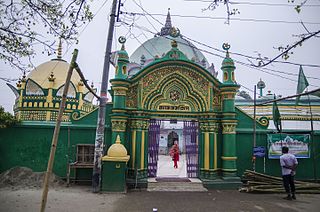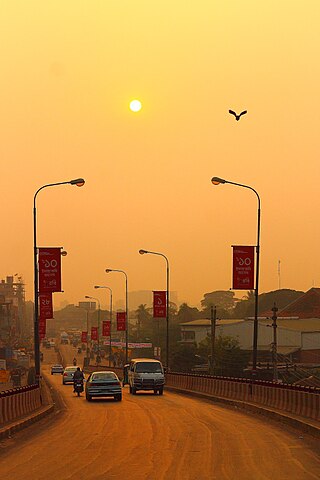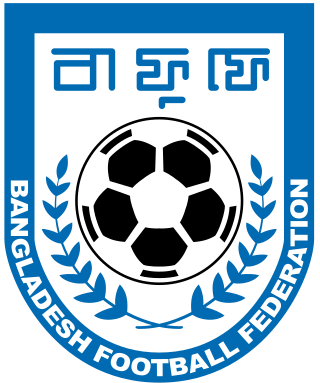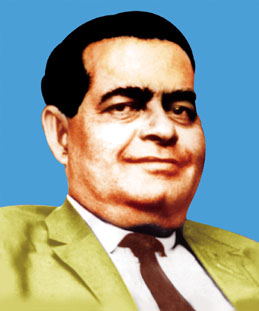Related Research Articles

Huseyn Shaheed Suhrawardy was a Bengali barrister and politician. He served as the Prime Minister of Pakistan from 1956 to 1957 and before that as the Prime Minister of Bengal from 1946 to 1947 in British India. In Pakistan, Suhrawardy is revered as one of the country's founding statesmen. In Bangladesh, Suhrawardy is remembered as the mentor of Bangladesh's founding leader Sheikh Mujibur Rahman. In India, he is seen as a controversial figure; some hold him responsible for the 1946 Calcutta Killings, for which he is often referred as the "Butcher of Bengal” in West Bengal. In India he is also remembered for his performance as the Minister for Civil Supply during the Bengal famine of 1943.

Dhaka Medical College and Hospital is a public medical college and hospital located in Dhaka, the capital city of Bangladesh. It houses medical school as well as a tertiary care hospital on one campus.

Mymensingh is a district in Mymensingh Division, Bangladesh, and is bordered on the north by Meghalaya, a state of India and the Garo Hills, on the south by Gazipur District, on the east by the districts of Netrokona and Kishoreganj, and on the west by the districts of Sherpur, Jamalpur and Tangail. Mymensingh is the 8th administrative divisional headquarter and 12th city corporation of Bangladesh. According to Ministry of Public Administration, Mymensingh is ranked 4th in district status. The density of Mymensingh city is 44,458/km2 which is the second most densely populated city in Bangladesh. Mymensingh attracts 25 percent of health tourists visiting Bangladesh. Once known as the largest district of the Indian subcontinent. Mymensingh town is the district headquarters. Mymensingh had the largest economy in the nation until Mohokuma Tangail rebelled and took over more than one-third of its land by the support of Pakistan's dictatorship.

Sirajganj District is a district in the North Bengal region of Bangladesh, located in the Rajshahi Division. It is an economically important district of Bangladesh. Sirajganj district is the 25th largest district by area and 9th largest district by population in Bangladesh. It is known as the gateway to North Bengal.

Sirajganj is a city in north-western Bangladesh on the right bank of the Jamuna River. It is the administrative headquarters of Sirajganj District, and with a population of 167,200 is the fourteenth most populous city in the country. It is about 110 kilometres (68 mi) north west of the capital, Dhaka. It is the city where Pakistani Brig. Jehanzeb Arbab looted the bank back in 1971 during Bangladesh liberation war. It was once a principal centre of the jute trade.

Tongi is a major township in Gazipur, Bangladesh, with a population of 350,000. It hosts the Biswa Ijtema and features a BSCIC industrial area, which produces BDT 1500 crore of industrial products annually, and marks the northern border of Dhaka since 1786. Tongi Shahid Smrity high School compound is mass burial site of the genocide in Liberation War of Bangladesh.

Bangladesh Football Federation is the governing body that administrates the sport of association football in Bangladesh. It is in charge of running the country's men's and women's national teams, as well as the Bangladesh Premier League and various other competitions and tournaments. The BFF was one of founding members of the South Asian Football Federation. It is based at BFF Bhaban, in the Motijheel Thana of the country's capital, Dhaka.

Abdul Jabbar was a protester who was killed during the Bengali language movement in 1952 that took place in the erstwhile East Pakistan. He is considered a martyr in Bangladesh.

Bangabandhu Sheikh Mujib Medical University (BSMMU) is a graduate medical university in Bangladesh. It was established in 1965. The university offers postgraduate degrees only, not offering undergraduate medical or dental degrees.

Tofazzal Hossain, popularly known as Manik Miah, was a Pakistani Bengali journalist and politician. He served as the founding editor of The Daily Ittefaq. He wrote the editorial Rajnoitik Moncho. Most of his journalists were considered leftist as Miah followed the pattern of Awami League. According to journalist and editor of Shongbad Bozlur Rahman, Awami activists followed his editorial more than any actual decision of a meeting. He was a close associate of the founder of Bangladesh, Sheikh Mujibur Rahman.

Abdul Monem Khan was a Pakistani politician who was the longest serving governor of East Pakistan during 1962–1969.
Shaheed Suhrawardy Medical College (ShSMC) is a public medical college and hospital located in Dhaka, the capital city of Bangladesh. This medical college is the third public medical college in the government medical college rank after DMC & SSMC. It has been included in the Avicenna Directory of Medical Schools and International Medical Education Directory (IMED).

Kaan Pete Roi is an emotional support helpline in Bangladesh.

Mesbahuddin Ahmed, known by his stage name Wasim, was a Bangladeshi film actor.
Abdur Rahim was a Bangladesh Army officer who served as the Director General of National Security Intelligence from 2001 to 2005.
Abbas Ali Mandal was a Bangladesh Awami League politician who served as Member of Parliament of Joypurhat-1.
References
- 1 2 "Bangladesh Suicide". worldlifeexpectancy.com. Retrieved 15 November 2012.
- ↑ "Suicide on the rise in Bangladesh". Dhaka Tribune. 2018-03-27. Retrieved 2019-02-01.
- 1 2 "Survey says Bangladesh's 6.5 million people of suicide-prone" . Retrieved 15 November 2012.
- 1 2 3 "10,000 commit suicide a year". The Daily Star. Retrieved 15 November 2012.
- ↑ "Bangladeshi women 'at risk of suicide'". BBC News. Retrieved 16 November 2012.
- ↑ Selim, Nasima (2010). "An extraordinary truth? The Ādam "suicide" notes from Bangladesh". Mental Health, Religion & Culture. 13 (3): 223–244. doi:10.1080/13674670903061230.
- 1 2 "Mymensingh joint suicide defies common sense". No. 1. BDNews24.com. BDNews24.com. 12 July 2007. Retrieved 30 May 2016.
- ↑ "Kaan Pete Roi: An emotional support helpline in Bangladesh". UNB. 6 February 2022.
- ↑ Ahmad, M; Hossain, MZ (14 March 2011). "Hanging as a Method of Suicide: Retrospective Analysis of Postmortem Cases". Journal of Armed Forces Medical College, Bangladesh. 6 (2). doi: 10.3329/jafmc.v6i2.7273 .